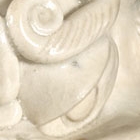J.J. Lally & Co., Oriental Art / New York City, New York
MenuPast Exhibition
The Gordon Collection:
Chinese Ceramics and Works of Art
March 12 - April 4, 2009
39.
A YINGQING GLAZED PORCELAIN ‘LION’ PILLOW
Song Dynasty (A.D. 960-1279)
the recumbent lion simply modelled, with large head turned to one side and resting its bearded chin on crossed forepaws, carved with staring eyes under heavy eyelids and applied curly eyebrows, the wide jaws partially open to show a row of teeth and a pair of sharp fangs, the side of the head detailed with incised hair markings and a cluster of impressed small circles, the flanks decorated with rouletted lines, applied at the front with a figure of a cub climbing over the lion’s bushy tail, the curved oval quatrefoil platform-headrest emerging from the lion’s back and projecting out on all sides, with down-turned edge cut straight across the back, covered with a clear glaze of very pale greenish tint, showing a light crackle all over, the plain flat base unglazed showing the hard white porcelain.
Length 6 3⁄4 inches (17.1 cm)
A Yingqing pillow in the form of a standing lion with similarly modelled head supporting an oval headrest on its back, in the collection of the Museum of Fine Arts, Boston, is illustrated by Wirgin, Sung Ceramic Designs, B.M.F.E.A., No. 42, Stockholm, 1970, pl. 36d.
Compare also the Yingqing glazed porcelain pillow with a curved quatrefoil headrest on the back of a striding lion excavated in Hubei, now in the Hubei Provincial Museum, illustrated in Zhongguo Taoci Quanji: Song (The Complete Works of Chinese Ceramics: Song), Vol. 8, Shanghai, 2000, no. 196, p. 214, with caption on p. 302.
宋 影青獅形枕 長 17.1 厘米
